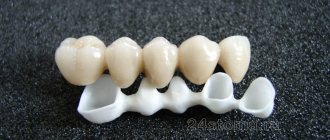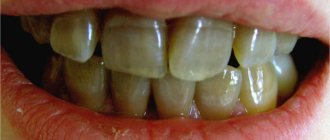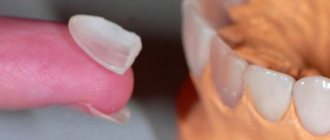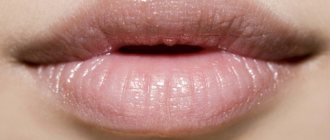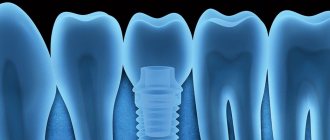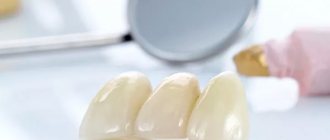17.05.2018
3588
- 1 Reason for changing the color of veneers
- 2 Darkened veneers photo
- 3 Troubleshooting methods
- 4 Prevention of darkening of veneers
Veneers can rightfully be considered a revolutionary achievement in aesthetic dentistry. They allow you to hide many dental defects without the need to resort to surgery, the use of braces and other methods that take time to achieve the desired result.
The greater the disappointment when it is discovered that the veneers have darkened. What could be causing this and how can I solve this problem?
Is it possible to whiten ceramic crowns and veneers, and what whitening methods does dentistry offer?
Dentures made of ceramics or metal-ceramics do not always satisfy the patient with their quality, since the materials can darken over time and be stained by food, drinks, and tobacco smoke. Either the crown or veneer was initially made darker than desired. A logical question arises: is it possible to whiten ceramic teeth? The answer is not always clear, but there is always a solution to the problem. Read more about this in today's article.
Contraindications
When deciding on the best way to restore the attractiveness of your teeth, proceed with caution. If you have one or more of the following symptoms, it is best to avoid installation:
- Serious diseases such as periodontitis and tooth mobility can become a serious contraindication;
- if the doctor has discovered that you have advanced caries;
- if there are significant malocclusions;
- a contraindication is also the habit of grinding your teeth in your sleep or using your teeth for other purposes (for example, opening plugs or gnawing on a pen or pencil);
- Avoid using dental veneers if your teeth wear down quickly.
Any teeth whitening procedure, despite its apparent simplicity, requires a professional approach and caution so as not to make things worse. If you want your teeth to shine with health and beauty, consult an experienced dentist, he will choose the best way.
What methods of whitening are there in dentistry?
Before we figure out how to whiten ceramic[1] teeth, let’s first look at what whitening methods exist. So, the methods by which you can whiten living enamel are essentially of two types:
- abrasive (mechanical): small and hard particles of the whitening agent scrape off plaque and pigmentation from the surface of the teeth. The clinic uses the Air-Flow hardware method for this, when a mixture of air, drops of water and fine powder is applied to the patient’s teeth under pressure. At home, pastes with a high abrasiveness index (RDA more than 100) are used. It is impossible to whiten stubborn stains, just as it is impossible to make teeth lighter than their natural shade,
- chemical: it whitens the enamel from the outside and a little from the inside - it depends on how deeply the bleaching agent penetrates. The whitening gel contains hydrogen peroxide and/or carbamide peroxide. Using this technique, you can lighten your teeth by 8-12 shades in a clinic and by 2-3 shades at home.
The chemical technique, in turn, can be supplemented by activating the whitening gel with a special lamp - LED, ultraviolet, laser. These are the most effective methods, because... they provide 10-12 shades of whitening.
How do you know when it’s time to change veneers?
Monitor the condition of the veneers, the quality of their fixation on the teeth, pay attention to microcracks, gaps and roughness - even in a small gap between the veneer and the enamel, bacteria will accumulate, which will lead to the destruction of living tooth tissue. Do not forget that in order to maintain the warranty on the product, you need to visit the dentist every six months - he will be able to assess the condition of the veneers and the teeth under them. He will also clarify that it is time to update the prostheses. However, this may be required after at least a couple of years if you do not take care of hygiene, and at least after 10 years (depending on the material) if you take care of your new teeth.
Choosing between veneers and lumineers? Only original Cerinate and DUO lumineers. No fakes, 100% quality guarantee.
sign up now
Can dentures be whitened?
Can ceramic teeth be whitened? Imagine ordinary dishes made of ceramics and glass - these compositions are inert to chemical bleaches, peroxide, vinegar and other acids, and alkalis. After all, even in laboratories, aggressive chemicals are stored in such containers - and the shade of their walls does not change.
Thus, ceramic veneers, crowns, restoration inlays, and bridges cannot be whitened using chemical methods. Or just lighten the surface darkening a little - and then while it is “fresh”. Those. until the dyes and plaque have eaten into the microscopic pores and cracks on the surface of the ceramic. Abrasive pastes will also only remove surface deposits, and can only harm the prosthesis itself - if solid particles scratch the top coating, it will lose its aesthetics even faster.
Lifetime
The duration of operation of the plate, which replaces the outer layer of teeth, depends on its strength.
Composite products are made from high quality composite filling composition. Patients prefer such products because of their affordable cost; moreover, this type of restoration can be used by any dentist.
But you shouldn’t count on long-term cosmetic effects. Such products remain on the surface of dental elements for no more than 5 years and quickly change their original shade.
Ceramic veneers have a longer service life. Due to their good resistance to staining and stress, such plates serve their owner for at least 15 years , and with good care this period can be doubled.
The effectiveness of dental restoration with plates depends on the following factors:
- material used in manufacturing;
- physiology of teeth;
- individual structural features of the dentofacial apparatus;
- food consumed by the patient;
- compliance with the recommended rules for caring for products.
The video provides additional information on the topic of the article.
What to do if ceramic dentures are darkened by plaque
How to whiten ceramic teeth that have become darker due to bacterial plaque? It has already been noted that it is impossible to bleach ceramics. But you can make it lighter with the help of dental procedures - for example, by removing tartar and plaque using professional oral hygiene. It is carried out by dentists - a therapist and a hygienist. The stone is very carefully removed from teeth and dentures using an ultrasonic scaler and hand instruments - it is important that the ultrasonic waves do not disturb the fixation of the orthopedic structure.
And plaque is removed with gentle air-abrasive Air-Flow (“Air-Flow”). Next, doctors use a professional paste for cleaning, and at the end of the procedure they perform polishing. An additional bonus of professional hygiene is that your own enamel becomes 1-2 tones lighter.
Important points
Another positive effect of veneering is the improvement of gum health. This happens thanks to the perfectly adjusted contours of the veneer.
But there may be cases when the gums begin to become inflamed, ache or bleed. If you notice such manifestations, then something is wrong. Maybe there were some errors during installation, and you will need to return to your doctor for correction.
The main factors in which you should immediately consult a dentist:
- sore gums, swelling, bleeding, discomfort;
- the veneer does not fit perfectly to the tooth, mobility is felt;
- the appearance of gaps or roughness at the attachment point;
- in case of a chip of a part of the prosthesis;
- at the first manifestations of caries in the exposed part of the tooth.
After assessing the situation, the dentist can replace or correct the veneer. For example, in cases where a small part of it has broken off, you can polish the desired area without replacing it.
Is it possible to lighten an artificial tooth that has been made too dark?
No, you won't be able to do this. After all, the shade of the ceramic is selected at the stage of making the prosthesis - then the product is baked in an oven, and the color is fixed forever. If the dentist made a mistake with the shade, then he will either have to redo the prosthesis (change the ceramic lining on a metal-ceramic crown, for example), or even make a new orthopedic structure.
There is another option - to apply a special white varnish on top of the ceramic prosthesis (for example, Dental Paint). It will paint the crown or veneer only on top, and after several cleanings it will wash off. Therefore, such a solution to the problem cannot be called a high-quality solution.
Why does a unit without pulp darken?
Some strips are flavored and scented for a more enjoyable experience. Strawberries The most delicious way to whiten teeth is strawberries.
The substances contained in these berries have a whitening effect. For the whitening procedure, you can prepare puree from fresh strawberries and strawberries and use it instead of paste. Coca-Cola When consumed cold, Coca-Cola leads to darkening of the enamel.
If it is not possible to achieve a trainer of entirely bleached cucumber planes, the bag will offer a complete restoration.
How to whiten darkened teeth if you have crowns and other dentures
If, while wearing ceramic dentures, your teeth become darkened by plaque or tobacco, you can whiten them. To do this, the dentist will select the optimal method for the patient, based on the condition of the teeth - whether they are healthy, whether they have cracks or fillings. Whitening methods in the clinic and at home have already been discussed above. But if, for example, only the old filling has darkened, then it is worth replacing it - putting a new one in the desired shade.
Read on the topic: artistic restoration with a filling - how to make your smile more attractive in 1 visit to the clinic.
You can also cover your natural teeth with veneers or crowns (if they are severely damaged) in a color that perfectly matches the shade of the crowns, bridges or veneers already in your mouth.
Reviews
Proper care of veneers is not difficult. But all recommended procedures aimed at proper hygiene require patience and systematicity.
Only high-quality care and careful handling of products will help you maintain a perfect smile and attractive appearance for a long time.
If after reading the article you have a desire to talk about your personal experience of quality care for the products presented, leave your review in the comments below.
If you find an error, please select a piece of text and press Ctrl+Enter.
Tags veneers care
Did you like the article? stay tuned
Previous article
The essence of ultrasonic dental implantation and aspects of its implementation
Next article
Are canine braces the only way to correct a “vampire smile”?
What can you do at home?
It is impossible to strongly whiten ceramic teeth at home. But maintaining them in their original condition, as well as removing a thin layer of plaque, is possible if you adhere to the following recommendations:
- rinse your mouth with water after every meal or if you have drunk a brightly colored drink (tea, coffee, wine, grape or pomegranate juice),
- thoroughly brush your teeth and dentures: morning and evening, sweeping movements from the gums to the incisal edge,
- use special toothpastes: on the shelves of stores and pharmacies they are marked “for dentures” and “for braces.” For example, such products are produced by the brands ROCS PRO Brackets & Ortho, Corega 2 in 1, SILCAMED,
- It is also better to buy a special toothbrush, with a large number of bristles: for example, from the company CURAPROX,
- carefully use long-lasting lip cosmetics so that they do not come into contact with artificial teeth,
- Visit your dentist regularly for checkups and professional, gentle cleanings.
“After undergoing prosthetics with ceramic crowns, I immediately bought myself a toothpaste, which I used with braces at school. Cleans very well, teeth are always white and little plaque appears. It is, of course, not very cheap. But not too expensive, quite acceptable for maintaining beauty. And, of course, I go to my dentist once a year or even more often. Because professional hygiene is the best way to clean plaque and tartar, because they build up in all people over time.”
Katty, review from the woman.ru forum
Principles of care
The basic rules for caring for veneers are not too different from normal oral hygiene. You won't be required to change your daily routine or carry a toothbrush with you everywhere. But some points should still be taken seriously.
Immediately after veneering, you should minimize the consumption of food and drinks with coloring properties.
First of all, these are coffee, tea, red wine, chocolate, beets. These foods do not require complete exclusion from the diet, but it is better not to get carried away with them. It is also worth giving up smoking, because exposure to nicotine will significantly worsen the cosmetic effect you have achieved.
Veneers themselves do not perform any protective functions. Their design is designed for certain chewing loads, but it is highly undesirable to overload them.
Therefore, you should not allow hard objects to come into contact with your teeth. You cannot bite nuts, caramel, gnaw seeds, or use your teeth to open lids and packages. Otherwise, there is a risk of splitting the prosthesis, or even damaging the tooth itself. For sports, it is recommended to use special mouthguards that will protect teeth from mechanical damage.
How to protect yourself from problems with dentures
In order for new teeth to maintain an attractive appearance for a long time and not cause other problems, you must initially carefully approach the choice of a clinic and an orthopedic dentist. It is advisable if dentistry has its own dental laboratory, where modern and high-quality ceramic materials are used. For example, ceramics, glass ceramics, fluorapatite, zirconium dioxide from Ivoclar Vivadent (IPS E.Max), Prettau, Kuraray Noritake, VITA Zahnfabrik. And the specialists were trained by material manufacturers, i.e. know how to handle them correctly.
Another important step is that before prosthetics, professional cleaning with ultrasound and Air-Flo is required, and sometimes professional whitening. After all, if your enamel is covered with plaque, then it looks darker than its natural shade - that is, the prosthesis will be made the same color. And then the patient wants to whiten his teeth or even just have his teeth professionally cleaned - as a result, the crown or veneer will turn out to be darker than the rest of the row. Therefore, do not neglect professional cleaning BEFORE prosthetics - a good dentist himself will offer to undergo it, because... understands all the risks.
Sign up for veneer installation at a discount:
— Can a veneer stand next to a crown?
If you think figuratively, then a veneer is the same as a crown. A veneer covers only the front part of the tooth, while a crown covers the entire tooth. To install a crown, we grind down the tooth on all sides. I am now talking about a metal-free, thin crown made of “E-max” material. It is convenient; when installing it, the tooth surface is preserved as much as possible. There are zirconium crowns, they also look quite aesthetically pleasing, they are also placed on the front teeth, but the tooth will have to be sharpened more, since the material is thicker due to the frame.
Veneers, by the way, are also made from zirconium. But in my practice, I prefer to work with E-max ceramic veneers. Since zirconium veneers cannot give us the same aesthetic effect that we get from ceramic ones. Natural teeth have a lot of nuances, it is extremely difficult to replicate them. The dental technician does a lot of work on each veneer - they apply a transparent layer, like a natural tooth, and carefully work with paints to get the color right. For example, dry and wet teeth differ in color, all this must be taken into account.
— What do you recommend to patients with crooked teeth: to get veneers or to undergo orthodontic treatment first?
Quite often, patients come to us who do not want to undergo orthodontic treatment and want veneers immediately. They believe that braces or mouth guards are time-consuming, expensive, even painful and unsightly. In fact, such patients are looking for an “easier way” to solve the issue of smile aesthetics and agree to have their teeth sharpened and veneers installed.
In general, if we talk about standard dental treatment, then it is correct to first undergo orthodontic treatment, and then improve the shape and color of the teeth.
We insist on orthodontic treatment if the problem is really severe, and if the patient refuses orthodontics, then we do not accept such a patient.
Abroad, by the way, they do not begin dental prosthetics or install veneers until the patient undergoes orthodontic treatment. It is important to obtain the correct closure and alignment of the teeth; this cannot be achieved using only the installation of aesthetic onlays. If the teeth are crooked, they will have to be sharpened a lot, they will become fragile and may not withstand the structure. Therefore, it is better to spend one and a half to two years on orthodontic treatment, but then get a good long-term result.
To summarize, I will say that you cannot put a veneer on a crooked tooth, since the load on it will be distributed incorrectly.
— What are Lumineers?
Lumineers are super thin veneers. They are also an onlay for a tooth, but they do not require grinding of the tooth to install them. This design is quite thin - from 0.2 to 0.3 mm, while veneer is from 0.4 to 1.5 mm. Lumineers are an unreliable design that does not last long. It can be placed only in rare cases, for example, when the patient has straight, good teeth and needs to solve minor cosmetic problems, such as, for example, a gap between the teeth (diastema). The doctor also takes an impression, a structure is made, which is then attached to the tooth with special material.
— What is “veneering”?
This is also a “populist” inexpensive design. Veneering is not carried out by orthopedic doctors, but by aesthetic therapists, who usually place fillings and restore teeth with composite materials. Veneering is a universal plastic structure with white, even, square teeth, where the color and size are selected “by eye” and not individually. Many patients undergo veneering and are satisfied, everyone has different tastes... Dentists among themselves call such teeth “Orbital pads.” I don't work with such designs.
Price question: how much does it cost to install veneers?
As we already said, dental veneers are not cheap, but they are worth it!
Approximate cost of microprostheses:
- Composite ones are the most budget-friendly. The cost of one unit is approximately 7 thousand rubles;
- Ceramic microprostheses, which are manufactured in a dental laboratory, cost approximately 20 thousand rubles per unit;
- Ceramic dental veneers made at the 32 Dent clinic will cost the patient about 15 thousand rubles per unit;
- Lumineers are the most expensive - from 50 thousand rubles per unit.
Can I use dental floss?
There are no clear prohibitions on the use of dental floss and interdental brushes, but you need to be extremely careful when using them. After prosthetics, microgaps between teeth are naturally preserved. But here it is very important not to move the thread from the gums to the edges (i.e., not to make vertical movements) - of course, not immediately, but gradually due to such actions the lining can be damaged. If you want to use floss, insert the tip not from below (from the cutting surface), but directly into the area between the teeth in the gum area - into the largest gap. After cleaning, remove it in the same way.
The same with brushes - when you remove them from the interdental space, be extremely careful. Choose the thinnest brushes. And best of all, buy an irrigator. This is an excellent replacement for both dental floss and brushes.
“Pay special attention to the condition of the gums, especially where the mucous membrane comes into contact with the edge of the veneer or lumineer. Due to tissue injury, inflammation may occur, which will lead to the fact that the pads will have to be removed for treatment, or due to a violation of aesthetics. For example, if gum recession begins and the roots of the teeth become exposed.”
